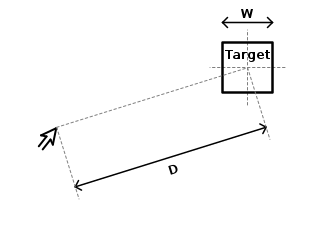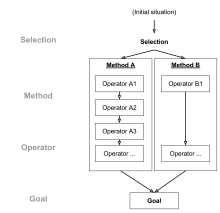
Fitts's law is a predictive model of human movement primarily used in human–computer interaction and ergonomics. The law predicts that the time required to rapidly move to a target area is a function of the ratio between the distance to the target and the width of the target. Fitts's law is used to model the act of pointing, either by physically touching an object with a hand or finger, or virtually, by pointing to an object on a computer monitor using a pointing device. It was initially developed by Paul Fitts.

Usability can be described as the capacity of a system to provide a condition for its users to perform the tasks safely, effectively, and efficiently while enjoying the experience. In software engineering, usability is the degree to which a software can be used by specified consumers to achieve quantified objectives with effectiveness, efficiency, and satisfaction in a quantified context of use.
A heuristic evaluation is a usability inspection method for computer software that helps to identify usability problems in the user interface (UI) design. It specifically involves evaluators examining the interface and judging its compliance with recognized usability principles. These evaluation methods are now widely taught and practiced in the new media sector, where UIs are often designed in a short space of time on a budget that may restrict the amount of money available to provide for other types of interface testing.
Interaction design, often abbreviated as IxD, is "the practice of designing interactive digital products, environments, systems, and services." Beyond the digital aspect, interaction design is also useful when creating physical (non-digital) products, exploring how a user might interact with it. Common topics of interaction design include design, human–computer interaction, and software development. While interaction design has an interest in form, its main area of focus rests on behavior. Rather than analyzing how things are, interaction design synthesizes and imagines things as they could be. This element of interaction design is what characterizes IxD as a design field as opposed to a science or engineering field.
The following outline is provided as an overview of and topical guide to human–computer interaction:
The cognitive walkthrough method is a usability inspection method used to identify usability issues in interactive systems, focusing on how easy it is for new users to accomplish tasks with the system. A cognitive walkthrough is task-specific, whereas heuristic evaluation takes a holistic view to catch problems not caught by this and other usability inspection methods. The method is rooted in the notion that users typically prefer to learn a system by using it to accomplish tasks, rather than, for example, studying a manual. The method is prized for its ability to generate results quickly with low cost, especially when compared to usability testing, as well as the ability to apply the method early in the design phases before coding even begins.
Task analysis is the analysis of how a task is accomplished, including a detailed description of both manual and mental activities, task and element durations, task frequency, task allocation, task complexity, environmental conditions, necessary clothing and equipment, and any other unique factors involved in or required for one or more people to perform a given task.
Human-centered computing (HCC) studies the design, development, and deployment of mixed-initiative human-computer systems. It is emerged from the convergence of multiple disciplines that are concerned both with understanding human beings and with the design of computational artifacts. Human-centered computing is closely related to human-computer interaction and information science. Human-centered computing is usually concerned with systems and practices of technology use while human-computer interaction is more focused on ergonomics and the usability of computing artifacts and information science is focused on practices surrounding the collection, manipulation, and use of information.

Ben Shneiderman is an American computer scientist, a Distinguished University Professor in the University of Maryland Department of Computer Science, which is part of the University of Maryland College of Computer, Mathematical, and Natural Sciences at the University of Maryland, College Park, and the founding director (1983-2000) of the University of Maryland Human-Computer Interaction Lab. He conducted fundamental research in the field of human–computer interaction, developing new ideas, methods, and tools such as the direct manipulation interface, and his eight rules of design.
In human–computer interaction, the keystroke-level model (KLM) predicts how long it will take an expert user to accomplish a routine task without errors using an interactive computer system. It was proposed by Stuart K. Card, Thomas P. Moran and Allen Newell in 1980 in the Communications of the ACM and published in their book The Psychology of Human-Computer Interaction in 1983, which is considered as a classic in the HCI field. The foundations were laid in 1974, when Card and Moran joined the Palo Alto Research Center (PARC) and created a group named Applied Information-Processing Psychology Project (AIP) with Newell as a consultant aiming to create an applied psychology of human-computer interaction. The keystroke-level model is still relevant today, which is shown by the recent research about mobile phones and touchscreens.
Cognitive ergonomics is a scientific discipline that studies, evaluates, and designs tasks, jobs, products, environments and systems and how they interact with humans and their cognitive abilities. It is defined by the International Ergonomics Association as "concerned with mental processes, such as perception, memory, reasoning, and motor response, as they affect interactions among humans and other elements of a system. Cognitive ergonomics is responsible for how work is done in the mind, meaning, the quality of work is dependent on the persons understanding of situations. Situations could include the goals, means, and constraints of work. The relevant topics include mental workload, decision-making, skilled performance, human-computer interaction, human reliability, work stress and training as these may relate to human-system design." Cognitive ergonomics studies cognition in work and operational settings, in order to optimize human well-being and system performance. It is a subset of the larger field of human factors and ergonomics.
Human processor model or MHP is a cognitive modeling method developed by Stuart K. Card, Thomas P. Moran, & Allen Newell (1983) used to calculate how long it takes to perform a certain task. Other cognitive modeling methods include parallel design, GOMS, and keystroke-level model (KLM).
Exploratory search is a specialization of information exploration which represents the activities carried out by searchers who are:
Wayne D. Gray is a professor of cognitive science and director of the cognitive science doctoral program at Rensselaer Polytechnic Institute.
NGOMSL is a variation of the GOMS technique in human computer interaction.
CMN-GOMS stands for Card, Moran and Newell GOMS. CMN-GOMS is the original version of the GOMS technique in human computer interaction. It takes the name after its creators Stuart Card, Thomas P. Moran and Allen Newell who first described GOMS in their 1983 book The Psychology of Human Computer Interaction.
CPM-GOMS is a variation of the GOMS technique in human computer interaction. CPM-GOMS stands for two things: Cognitive Perceptual Motor and the project planning technique Critical Path Method.

Human–computer interaction (HCI) is research in the design and the use of computer technology, which focuses on the interfaces between people (users) and computers. HCI researchers observe the ways humans interact with computers and design technologies that allow humans to interact with computers in novel ways. A device that allows interaction between human being and a computer is known as a "Human-computer Interface (HCI)".
Bonnie E. John is an American cognitive psychologist who studies human–computer interaction, predictive human performance modeling, and the relationship between usability and software architecture. She was a founding member of the Human-Computer Interaction Institute at Carnegie Mellon University, a research staff member at IBM's Thomas J. Watson Research Center, and the director of computation and innovation at The Cooper Union. She is currently a UX designer at Bloomberg L.P.
Human performance modeling (HPM) is a method of quantifying human behavior, cognition, and processes. It is a tool used by human factors researchers and practitioners for both the analysis of human function and for the development of systems designed for optimal user experience and interaction. It is a complementary approach to other usability testing methods for evaluating the impact of interface features on operator performance.




